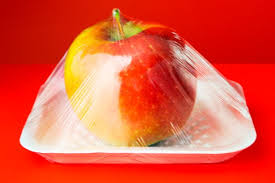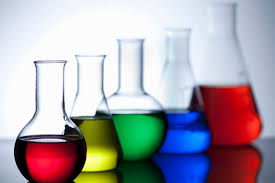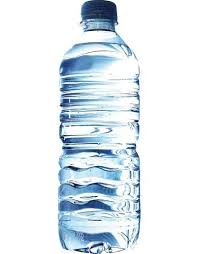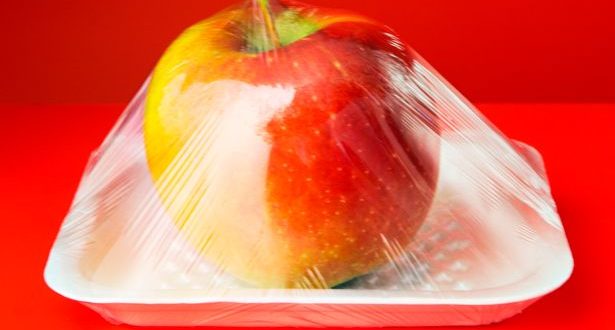I can remember growing up in the sixties in a world which was still relatively “plastic free”. Do you remember when foods were actually packaged in glass, paper, and cardboard? Do you also remember when the paper and cardboard was thicker back then? I can still remember as a boy looking at one of those “foam” cups made from polystyrene and crumbling it, it was in the late sixties, wondering what the heck it was made of! The one litre Coke bottle was made from glass a long time ago, and it bloody well hurt when your brother whacked you on the backside with it. No foods were stored nor packaged in plastic, and the grocery store bags were a thick brown paper, not those flimsy plastic bags of today which you can just about “spit” through.
 The only toys I had as a boy which were made from plastic were those little green plastic soldiers from China, my Matchbox cars, my Triang tricycle and later on my Raleigh bicycle were all made from good solid British metal with minimal if any plastic parts. Back then, China was the word used for something you drank a cup of tea out of, not found on a sticker on just about everything you buy from a shop involving any type of plastic.
The only toys I had as a boy which were made from plastic were those little green plastic soldiers from China, my Matchbox cars, my Triang tricycle and later on my Raleigh bicycle were all made from good solid British metal with minimal if any plastic parts. Back then, China was the word used for something you drank a cup of tea out of, not found on a sticker on just about everything you buy from a shop involving any type of plastic.
Today, it is hard to find any toy which is not 100% plastic, amazing! And the scientists call it “better living through chemistry”. I would like to believe that my great grandchildren will live in a world one day where chemistry will go green, and scientists may one day understand the serious health risks imposed on a population growing up in today’s plastic world.
This article will focus on what a lot of people have been talking about – plastics in our foods, and in water – I take it you drink bottled water?
There is no “best plastic” to contain food or drink. It is my hope that this article will clarify this viewpoint. By the time you’ve finished reading, you should be closer to forming your own evaluation of plastics, and hopefully you will try to reduce your exposure and use of plastics in your everyday living.
 Unlike the sixties, plastic today is used in contact with nearly every single packaged food. Most cardboard drink and milk containers are now even coated with plastic rather than wax. In many countries, a type of liquid plastic compound is even sprayed on both commercial and organic produce to preserve its freshness. Yes, crazy as it may seem, but in many cases plastic is even used to irrigate, mulch, wrap, and transport organic foods. “Organic” bananas come from overseas South American wholesalers with a fungicide containing sticky plastic wrapping the cut stem to protect the bananas from a black mould. These so called organic bananas themselves are wrapped in a plastic as they grow to prevent fruit bats from getting to them. Did you know that whenever you eat or drink things that are stored in plastic, or if you taste it, smell it, wear it, sit on it, and so on, then that plastic actually becomes a part you?
Unlike the sixties, plastic today is used in contact with nearly every single packaged food. Most cardboard drink and milk containers are now even coated with plastic rather than wax. In many countries, a type of liquid plastic compound is even sprayed on both commercial and organic produce to preserve its freshness. Yes, crazy as it may seem, but in many cases plastic is even used to irrigate, mulch, wrap, and transport organic foods. “Organic” bananas come from overseas South American wholesalers with a fungicide containing sticky plastic wrapping the cut stem to protect the bananas from a black mould. These so called organic bananas themselves are wrapped in a plastic as they grow to prevent fruit bats from getting to them. Did you know that whenever you eat or drink things that are stored in plastic, or if you taste it, smell it, wear it, sit on it, and so on, then that plastic actually becomes a part you?
In fact, when any food gets into plastic – the plastic gets into the food and eventually you. So, quite literally, you are what you eat. . drink . . . and breathe — plastic!
The Low-Dose Threat
Plastic is everywhere in our lives because it is convenient and relatively inexpensive. It is widelt regarded and advertised as safe and that it even “saves lives”. The problem with plastic is that its safety is based on an outdated science and flimsy regulations. And while it may saves lives in the short run, the record against plastic is looking quite different. Its convenience comes from being lightweight and it comes in an endless range of colors and finishes, is pliable, and is easily formed and molded. Most would say it’s a perfect material, right? But – here’s where the bad news begins. It is interesting when you consider that there between 87,000 to 100,000 chemicals in commercial production registered with the Chemical Abstracts Service (CAS) registry. Of all these chemicals, only about 200 have been tested on humans, and most never on pregnant women or children.
Consider this – If you want to market a new pharmaceutical drug, you will need to convince the authorities like Medsafe or the FDA, in multiple tests over the course of many years of clinical trials that it won’t cause serious harm. If you want to sell a new sheep drench or pesticide, you will need to prove the same thing. The manufacturers have to prove the chemicals in these concoctions are “safe” and the government makes the final decision. But what if you want to market a brand new chemical, not a drug or a pesticide, just a chemical? And what if this chemical comes into contact with a young child or pregnant woman? I’m not sure about NZ, but I expect it’s much the same as in America; it is up to the Environmental Protection Agency (EPA) to prove that it is unsafe, using whatever chemical data is supplied by the chemical manufacture, with little power to ask for more information. Chances are it was never really tested by the government at all.
According to Richard Wiles, executive director of the non-profit Environmental Working Group in the USA: “It’s completely backwards”. As bio-monitoring has improved, scientists can now detect human exposure levels of chemicals as small as one part per trillion, which is about a twentieth of a drop of water in an Olympic sized swimming pool. Scientists have also discovered that humans are carrying far more chemicals than previously thought. And because of this, for example, scientists have learned that some toxins are extremely toxic even at very low levels.
 Take a look at lead for example, the “safe” limit for lead (which can directly reduce a person’s IQ) has been lowered from 60 micrograms per deciliter (100mls) of blood down to 10 mcg. And that discovery was only made in 1970! Now imagine for one minute what kind of understanding we will have about heavy metals like mercury, cadmium, arsenic and lead, and not to mention all those zillions of chemicals like plastics in our blood forty years from now – in 2050. That’s right, we will have a much better understanding and will wonder how chemical manufacturers actually got away with it all those years. Better living through corruption, lies and corporate greed? The next global crisis may not be in terms of dollars, but chemical toxicity as we drown in our own
Take a look at lead for example, the “safe” limit for lead (which can directly reduce a person’s IQ) has been lowered from 60 micrograms per deciliter (100mls) of blood down to 10 mcg. And that discovery was only made in 1970! Now imagine for one minute what kind of understanding we will have about heavy metals like mercury, cadmium, arsenic and lead, and not to mention all those zillions of chemicals like plastics in our blood forty years from now – in 2050. That’s right, we will have a much better understanding and will wonder how chemical manufacturers actually got away with it all those years. Better living through corruption, lies and corporate greed? The next global crisis may not be in terms of dollars, but chemical toxicity as we drown in our own
The next global crisis may not be in terms of dollars, but chemical toxicity as we drown in our own man-made chemical concoctions. Why not become aware of your body’s burden right now and undergo regular annual detoxification of your liver and kidneys? Try to reduce the amount of exposure you have to plastic and chemicals in your life today, I’ll talk more about this later.
Bisphenol-A (BPA)
 Do you drink water from those plastic water bottles? Water bottles are be made from various types of plastic — polycarbonate (PC), polyethylene terephthalate (PET), Polypropylene (PP), high-density polyethylene (HDPE), low-density polyethylene (LDPE), polyvinyl chloride (PVC or vinyl), and others. All these chemicals migrate throughout the body to some degree, let’s just for now focus on just one chemical that migrates out of one plastic and that is used to make products with high use and sales profiles – BPA.
Do you drink water from those plastic water bottles? Water bottles are be made from various types of plastic — polycarbonate (PC), polyethylene terephthalate (PET), Polypropylene (PP), high-density polyethylene (HDPE), low-density polyethylene (LDPE), polyvinyl chloride (PVC or vinyl), and others. All these chemicals migrate throughout the body to some degree, let’s just for now focus on just one chemical that migrates out of one plastic and that is used to make products with high use and sales profiles – BPA.
Bisphenol-A (BPA) is a chemical used in the manufacturing of many types plastics. It does its job well, and an incredible 2.7 million kgs are produced every year. The BIG problem with BPA is that it has been found to be a known source of synthetic hormones like oestrogen, and that plastics containing it can break down easily, especially when they are washed, heated or stressed in any way, allowing the chemical to leach into the food or water it is in contact with allowing it to enter the human body.
BPA has been found in the urine of 93% of People in America, and I suspect this figure to be the same in Australia and NZ. BPA can mimic hormones like adrenaline and testosterone as well as oestrogen and because minuscule amounts of these powerful hormones can cause major biological changes, imagine for one moment what your body does when it is bombarded with plastics containing BPA every day!
And now think what happens to a young person whose body is still developing. Kids are particularly vulnerable to chemical BPA toxicity because their smaller bodies are developing rapidly, and because they eat and drink more foods containing BPA relative to their bodyweight than adults do. This is exactly what scientists have found, linking fetal BPA in rodents to everything from cancers, genital defects and even many and varied behavioural disorders. Could this be part of the cause of our rising epidemic of ADHD, autism, Asperger’s syndrome and similar behavioural disorders? And it does not stop there. In 1998, Dr. Patricia Hunt, a geneticist in America, discovered that female mice dosed with BPA had serious reproductive disorders.
 According to Dr. Hunt, you disrupt three generations with one exposure to BPA. This is why BPA was consequently taken out of babies drinking bottles and banned in Sweden in 2008. President Obama called for a 30 million dollar study into BPA and human health. At last, at least somebody’s got the brains to look beyond the plastic corporate greed. Are you still using plastic baby bottles, or heat the baby’s plastic bottle in a microwave oven? You’d better not after reading this!
According to Dr. Hunt, you disrupt three generations with one exposure to BPA. This is why BPA was consequently taken out of babies drinking bottles and banned in Sweden in 2008. President Obama called for a 30 million dollar study into BPA and human health. At last, at least somebody’s got the brains to look beyond the plastic corporate greed. Are you still using plastic baby bottles, or heat the baby’s plastic bottle in a microwave oven? You’d better not after reading this!
The list of products containing BPA is really long. In the medical industry, it is used for syringes, containers, lenses, and various dental products. The mind blowing thing about plastic is that it is regulated only if it is in contact with foods and not any of the other exposures a person might commonly experience every day at home, school, or the office. Because the government approves plastics for specific uses rather than for individual chemicals, BPA is therefore not regulated. I think that it is important to note that all exposures, no matter what origin, are cumulative. The body’s natural defenses try to breakdown toxins such as BPA as they enter. These chemicals are what we call “metabolites” and can be significantly more toxic than the original chemical itself. Have they been tested? Yawn, not really.
In 2009, two German scientists looked at whether the migration of substances from plastic packaging material into foodstuffs contributes to human exposure to man-made hormones. They analysed 20 brands of water– including nine bottled in glass and nine bottled in plastic. The researchers took water samples from the bottles and carefully tested them for the presence of any estrogenic chemicals. They then carried out a reproduction test using New Zealand mud snails to determine the source and potency of the xeno-oestrogens (substances which resemble and act like estrogen in the body). They detected estrogen contamination in 60% of the samples (12 of the 20 brands) analysed. Specifically, 78% of the plastic bottled water showed significant hormonal activity.
By breeding the New Zealand mud snail in both plastic and glass water bottles, these researchers found more than double the number of embryos in plastic bottles compared with glass bottles. Taken together, these results demonstrate widespread contamination of water with potent man-made estrogens that partly originate from compounds leaching out of the plastic packaging material. The German authors conclude: “We have identified just the tip of the iceberg in that plastic packaging may be a major source of xeno-hormone (foreign hormone) contamination of many other edible foods. Our findings provide an insight into the potential exposure to hormone-disrupting chemicals due to unexpected sources of contamination.” Are you still thirsty for a “plastic” drink ? Try drinking out of a glass or stainless steel container. It may save you from a nasty condition one day, particularly if you drink lots of bottled water.
In April 2003, a study was published about BPA accidentally killing mice that had been held in polycarbonate cages at a lab. It was found accidentally when it ruined a lab experiment that heated yeast in plastic flasks to find out if the yeast produced any estrogen-like compounds. It was discovered that BPA from the plastic flasks was the material that was estrogenic, and that it competed with the natural estrogen in a rat’s body. When a well known researcher was asked why labs still use plastics considering what it has been known since 1993 that BPA migrates and is hormonally active. The response was, “What are we supposed to do, go back to glass?” This is the state of what is still amazingly called “science”, and as is usual with all too many research scientists, the truth maybe sought, but the obvious is pretty well trampled over in the stampede to secure that all too familiar pot of gold – the lucrative funding.
The list of negative health effects associated in some way with exposure to BPA is disturbingly long. The most visible effect may be a chromosome abnormality called “aneuploid”, found in more than 5% of pregnancies. Most aneuploid fetuses die in utero. About one-third of all miscarriages are aneuploid, making it the leading known cause of pregnancy loss. Exposure to BPA has been found in addition to increase risk of breast tumors. Being one of many known hormone disruptors, BPA affects development, intelligence, memory, learning, and behavior, skeleton, body size and shape, significant increase in prostate size, prostate cancer, reduced sperm count, and both physical and mental aspects of sexuality. It may have something to do with obesity, and so many more that a separate article is required to list them all. In other words, if the fetus lives, any one or many parts of its body can be permanently affected. The problems with BPA may become evident at any age, and to reiterate, there is no shortage of research published on the negative health effects of BPA. Do you still trust that plastic bottle?
By Eric Bakker ND









Join the Discussion
Type out your comment here:
You must be logged in to post a comment.